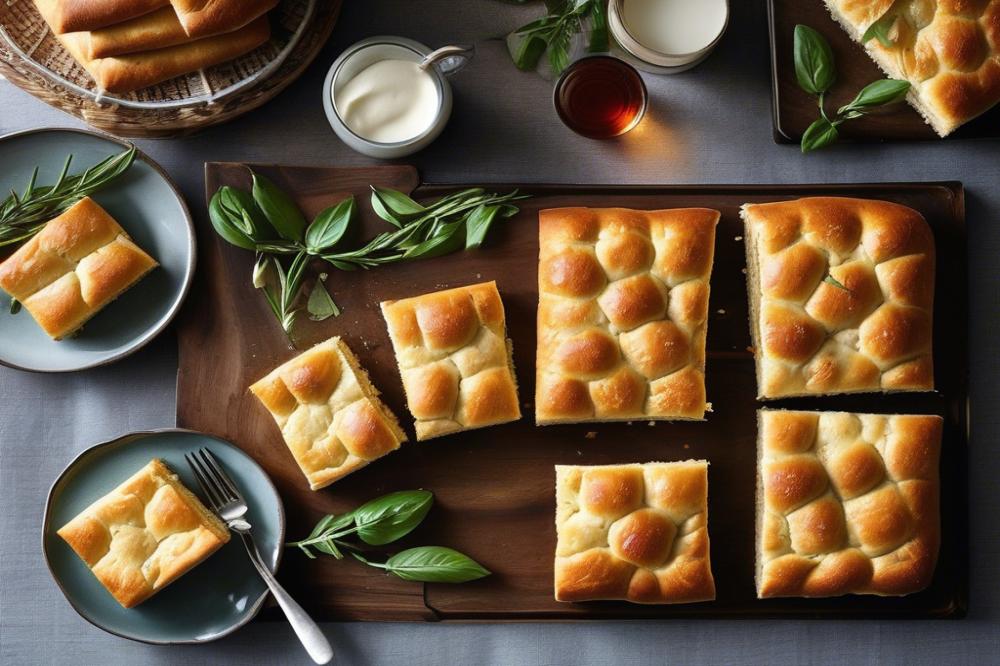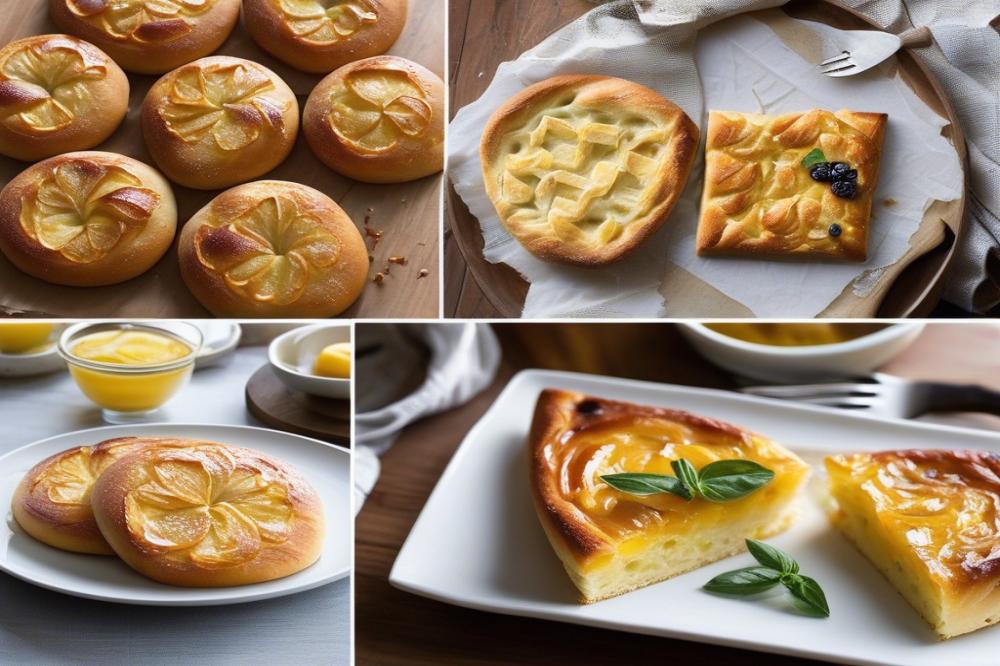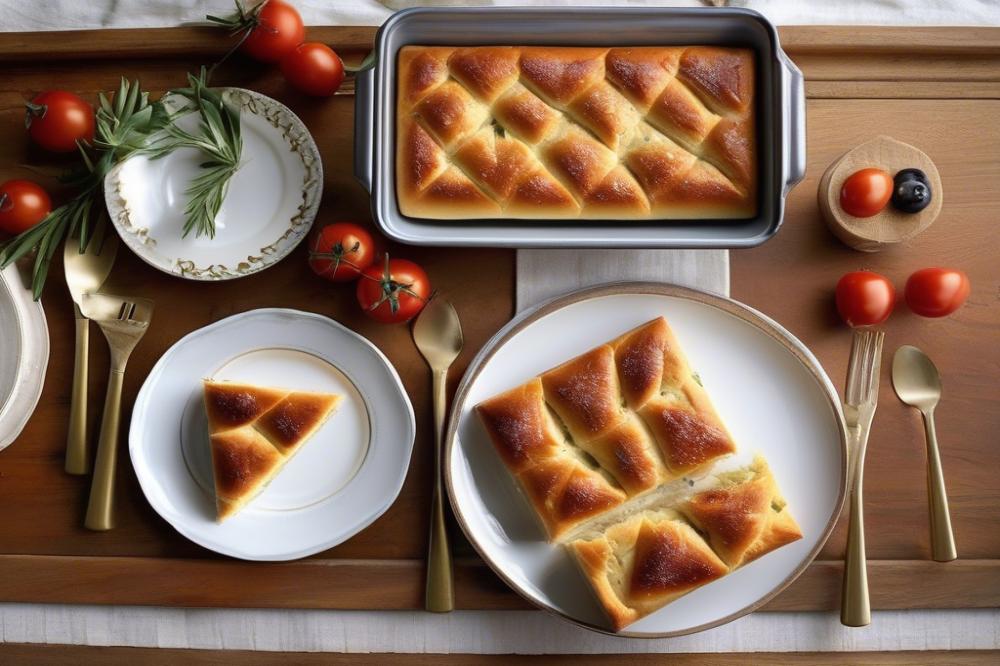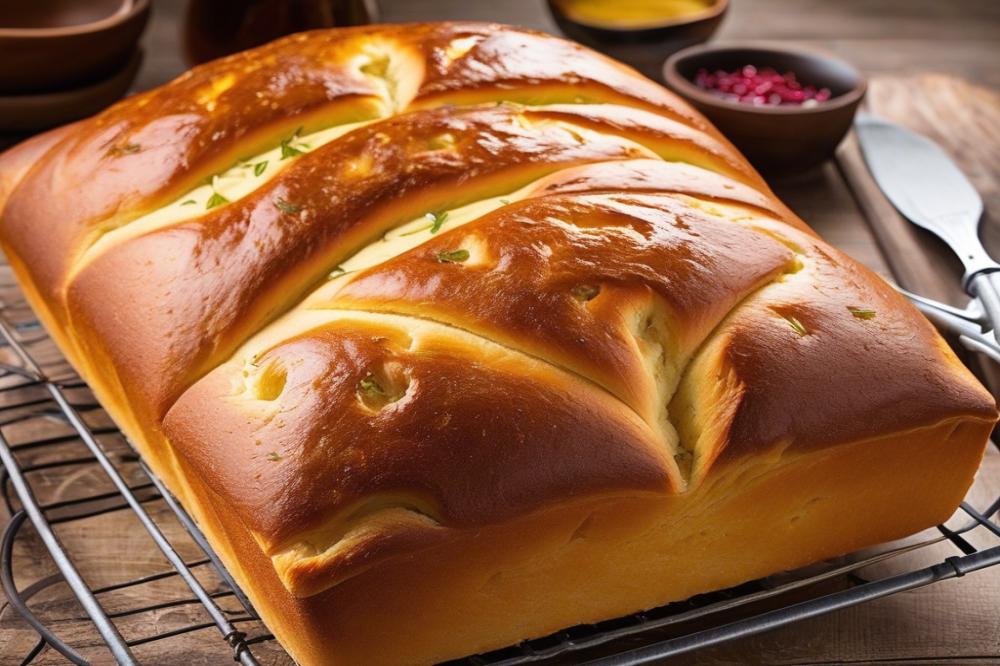Introduction
Italian Fugassa reflects the rich heritage of Italy’s diverse culinary traditions. This delectable treat is a sweet focaccia that provides a delightful twist on the standard focaccia bread known and loved throughout Italy. In the Venetian region, this bread is more than just food; it represents a piece of cultural identity. The unique flavors woven into each loaf make this Italian pastry a staple in homes and bakeries alike.
Venetian sweet focaccia holds particular significance during festive occasions, especially Easter. Families often gather to enjoy this traditional Italian bread as part of their celebrations. The presence of this delightful baked good on the table adds to the spirit of the holiday. During these times, you can smell the warm scent of olive oil focaccia inviting people in.
Different regions of Italy have their own specialties, and Venetian Focaccia is no different. Recipes may vary and include various ingredients, yet the essence remains the same. This dessert bread not only satisfies the palate but also brings people together. Enjoying Italian Fugassa creates memories that resonate long after the last piece is gone.
Understanding Italian Fugassa

The term Fugassa refers to a traditional sweet focaccia that has deep roots in Venetian cuisine. Known for its airy, fluffy texture and rich flavor, it stands out among Italian pastries. This dessert bread combines simple ingredients like flour, sugar, yeast, and olive oil to create a delightful treat. Each bite reflects the essence of baked goods that celebrate Italy’s diverse culinary traditions.
Italian Fugassa’s history can be traced back to ancient times, but its most recognizable form emerged in Venice. This Venetian recipe has been influenced over centuries by various cultures and traditions. The blend of spices, citrus, and sometimes even dried fruits adds character to this regional specialty. During festive seasons, such as Easter, this delicacy becomes a prominent feature at family gatherings. People make it to honor tradition and to share a piece of their heritage.
During Easter, Fugassa takes on special significance as it is often referred to as Easter bread. Families often bake this unique treat together, creating joyful memories in the kitchen. Slices of this sweet focaccia have become a staple on many holiday tables. It represents both celebration and togetherness, highlighting the importance of family in Italian culture. Enjoying Fugassa is more than just tasting a dessert bread; it is a cherished ritual that brings loved ones together during festive occasions.
Ingredients List and Cooking Instructions

Detailed Ingredients List with Quantities
To make the perfect sweet focaccia, gather the following ingredients:
- 500g all-purpose flour
- 100g granulated sugar
- 200ml lukewarm milk
- 75ml olive oil
- 10g active dry yeast
- 2 large eggs
- Zest of 1 lemon
- 1 tsp vanilla extract
- 1/2 tsp salt
- Optional toppings: sliced almonds, raisins, powdered sugar
Step-by-Step Cooking Instructions
Start by preparing the yeast mixture. In a small bowl, combine the active dry yeast with lukewarm milk. Allow it to sit for about 5 to 10 minutes until it becomes frothy.
Next, mix the dry ingredients. In a large bowl, whisk together the all-purpose flour, granulated sugar, and salt. This is the base for your Venetian recipe.
Combine the wet ingredients in another bowl. Beat the eggs, then add the frothy yeast mixture, olive oil, lemon zest, and vanilla extract to the eggs. Stir until everything is blended well.
Now, pour the wet mixture into the dry ingredients. Mix together to form a sticky dough. Do not worry if it appears messy at first; it will come together as you knead.
Kneading is important. Flour your working surface lightly. Turn the dough out and knead for about 10 minutes until it becomes smooth and elastic. Afterward, place the dough in a lightly greased bowl, cover it with a cloth, and let it rest in a warm area for about an hour. It should double in size.
Once the dough has risen, gently punch it down to release air. Prepare a baking tray by greasing it lightly with olive oil. Shape the dough into a rectangle or circle and place it on the tray. Cover once more and let it rise again for about 30 minutes, allowing the dough to puff up.
For the baking method, preheat your oven to 180°C (350°F). If you like, sprinkle sliced almonds or raisins over the dough before baking for added texture. Bake for 25 to 30 minutes until it turns golden brown. Once done, you may dust it with powdered sugar while it is still warm.
Nutritional Information

Understanding the nutritional value of Italian Fugassa helps appreciate this classic Venetian recipe. Each ingredient plays a role in its overall profile.
Breakdown of Nutritional Value for Each Ingredient
Flour serves as the base. Most recipes use all-purpose flour, which provides carbohydrates for energy. Sugar adds sweetness and also contributes simple carbs. Yeast helps the dough rise and does not contain significant calories. Eggs enrich the focaccia, providing protein and essential nutrients like Vitamin D. Olive oil brings healthy fats to the mix, which can be beneficial for heart health. Finally, citrus zests give flavor but add minimal calories.
Overall Nutrition Profile of Italian Fugassa
This sweet focaccia offers a moderate amount of calories per serving, especially when considering its size. A typical slice can range from 250 to 350 calories, depending on the amount of sugar and oil used. Protein content is reasonable due to the eggs, helping with muscle maintenance. Carbohydrates dominate the makeup, making it an excellent energy source. Healthy fats from olive oil support heart wellness, making it a more balanced treat compared to many other baked goods.
Health Considerations and Serving Suggestions
When enjoying this Italian pastry, moderation is key. Focus on portion size if watching calorie intake. Switching to whole wheat flour can increase fiber content, offering a healthier twist. Pairing a slice with fresh fruit can enhance nutrition further while maintaining sweetness. During special occasions like Easter, this festive bread becomes a traditional comforting treat, evoking memories of family gatherings. Keep in mind that while this dessert bread can be a delightful indulgence, it should complement a balanced diet. For those seeking lighter options, experimenting with less sugar or oil is advisable.
Serving Suggestions and Variations
Sweet focaccia is versatile and can be enjoyed in many ways. Some people prefer to serve it warm, while others like it at room temperature. It makes for a delightful breakfast item when paired with coffee or tea. You can also slice it into squares for a generous afternoon snack.
Pairing this delicious Italian pastry with beverages can enhance its flavor. A glass of bubbly Prosecco can be a nice match for this festive bread. Alternatively, a cup of rich hot chocolate complements the sweetness beautifully. For something refreshing, try serving it with iced herbal tea.
Regional Variations
Exploring the variations of this Venetian recipe reveals many regional specialties throughout Italy. In some areas, bakeries might create an Easter bread version with colorful eggs baked into the dough. Others add different fruits or nuts, creating distinct flavors and textures. In Liguria, you might find a version that incorporates rosemary and sea salt, giving it an earthy twist.
Some might use olive oil focaccia as a base, showcasing the rich flavors of this ingredient. It can be topped with honey and almonds, transforming it into a delightful dessert bread. Baked goods like this can vary significantly from region to region, making each one a unique experience.
Cultural Significance and Festive Uses
Italian Fugassa holds an important place in the fabric of Italian culture. This sweet focaccia is more than just a dessert bread; it is a symbol of tradition and family. In Venice, its recipe is often passed down through generations, highlighting its value as a cultural artifact. The act of baking and sharing this Italian pastry brings loved ones together, reinforcing bonds and shared history.
Festivals and special occasions often feature this beloved baked good. During Easter, many families serve fugassa as part of their celebratory meals. It is not uncommon to see variations adorned with colored sprinkles or dried fruits, adding to the festive atmosphere. Olive oil focaccia also complements gatherings, as it is versatile enough to accompany many dishes served during these times.
Different regions of Italy present their own specialties. For instance, some versions of fugassa include ricotta or citrus for added flavor, making each bite a delight. In northern regions, more dense and rich variations emerge, while southern parts may offer lighter, airier forms. Each adaptation provides a unique glimpse into local customs and tastes.
In gatherings, this festive bread often serves as a centerpiece. Friends and family come together to enjoy the aroma and texture of the fresh loaf, making it a pleasurable experience. Sharing this dish encourages conversation and adds warmth to the atmosphere, which is a hallmark of Italian hospitality.
Moreover, the preparation of dessert bread like fugassa can be a communal activity. Families often bake together, creating memories that last a lifetime. The blending of flavors and techniques showcases the diversity found in traditional Italian recipes, making the experience richer and more fulfilling.
Final Thoughts on Italian Fugassa
Recapping the significance of this sweet focaccia reveals more than just a tasty treat. In Venetian culture, Fugassa represents tradition and celebration. Family gatherings and festive occasions often feature this delightful Italian pastry. Its rich history and the love that goes into making it truly connect people across generations.
Consider the joy of trying to make this dish at home. The process of mixing ingredients and watching dough rise can be both exciting and rewarding. Baking your own Fugassa allows for personal touches, whether you add orange zest or choose to sprinkle sugar on top. Each bite will not only be filled with sweetness but also carry the warmth of your kitchen.
Incorporating traditional Italian baking into modern kitchens expands culinary horizons. Discovering recipes like Fugassa encourages appreciation for age-old techniques. It enhances everyday life and invites a sense of adventure in cooking. Ultimately, making this unique focaccia could lead to new family traditions, creating delicious memories to share for years to come. Try it! You might find a new favorite in this classic dish.

